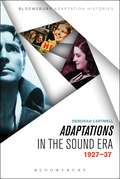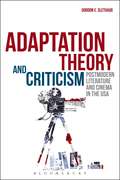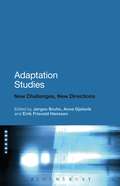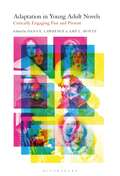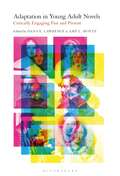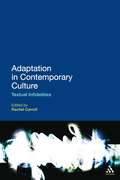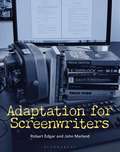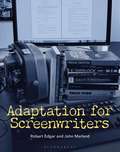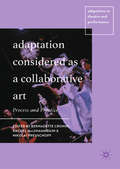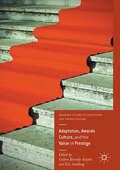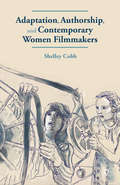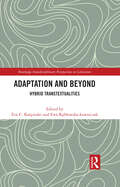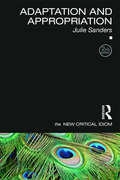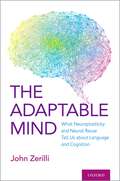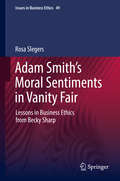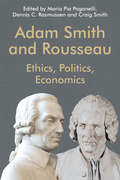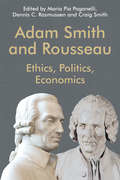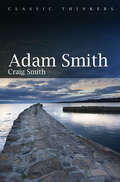- Table View
- List View
Adaptations in the Sound Era: 1927-37 (Bloomsbury Adaptation Histories)
by Deborah CartmellThere is no disputing that the coming of sound heralded a new era for adaptations. We take it for granted today that a film is enhanced by sound but it was not a view unanimously held in the early period of sound cinema. While there was a substantial degree of skepticism in the late 1920s and early 30s about the advantages of sound, what we would call technophobia today, the inclusion of speech in screen versions of literary and theatrical works, undeniably revised what it was to be an adaptation: words. Focusing on promotional materials, Adaptations in the Sound Era tracks early attempts to promote sound through the elevation of words in adaptations in the early sound period. The popular appeal of these films clearly stands in opposition to academic regard for them and the book reflects on the presence and marketing of 'words' in a variety of adaptations, from the introduction of sound in the late 1920s to the mid 1930s. This book contextualizes a range of adaptations in relation to debates about 'picturizations' of books in the early sound era, including reactions to the talking adaptation by writers such as, Irwin Panofsky, Aldous Huxley and Graham Greene. Film adaptations of Shakespeare, Dickens, gothic fiction and biopics are also discussed in relation to their use and promotion of sound or, more precisely, words.
Adaptations in the Sound Era: 1927-37 (Bloomsbury Adaptation Histories)
by Deborah CartmellThere is no disputing that the coming of sound heralded a new era for adaptations. We take it for granted today that a film is enhanced by sound but it was not a view unanimously held in the early period of sound cinema. While there was a substantial degree of skepticism in the late 1920s and early 30s about the advantages of sound, what we would call technophobia today, the inclusion of speech in screen versions of literary and theatrical works, undeniably revised what it was to be an adaptation: words. Focusing on promotional materials, Adaptations in the Sound Era tracks early attempts to promote sound through the elevation of words in adaptations in the early sound period. The popular appeal of these films clearly stands in opposition to academic regard for them and the book reflects on the presence and marketing of 'words' in a variety of adaptations, from the introduction of sound in the late 1920s to the mid 1930s. This book contextualizes a range of adaptations in relation to debates about 'picturizations' of books in the early sound era, including reactions to the talking adaptation by writers such as, Irwin Panofsky, Aldous Huxley and Graham Greene. Film adaptations of Shakespeare, Dickens, gothic fiction and biopics are also discussed in relation to their use and promotion of sound or, more precisely, words.
Adaptation Theory and Criticism: Postmodern Literature and Cinema in the USA
by Gordon E. SlethaugTraditional critics of film adaptation generally assumed a) that the written text is better than the film adaptation because the plot is more intricate and the language richer when pictorial images do not intrude; b) that films are better when particularly faithful to the original; c) that authors do not make good script writers and should not sully their imagination by writing film scripts; d) and often that American films lack the complexity of authored texts because they are sourced out of Hollywood. The 'faithfulness' view has by and large disappeared, and intertextuality is now a generally received notion, but the field still lacks studies with a postmodern methodology and lens.Exploring Hollywood feature films as well as small studio productions, Adaptation Theory and Criticism explores the intertextuality of a dozen films through a series of case studies introduced through discussions of postmodern methodology and practice. Providing the reader with informative background on theories of film adaptation as well as carefully articulated postmodern methodology and issues, Gordon Slethaug includes several case studies of major Hollywood productions and small studio films, some of which have been discussed before (Age of Innocence, Gangs of New York, and Do the Right Thing) and some that have received lesser consideration (Six Degrees of Separation, Smoke, Smoke Signals, Broken Flowers, and various Snow White narratives including Enchanted, Mirror Mirror, and Snow White and the Huntsman). Useful for both film and literary studies students, Adaptation Theory and Criticism cogently combines the existing scholarship and uses previous theories to engage readers to think about the current state of American literature and film.
Adaptation Theory and Criticism: Postmodern Literature and Cinema in the USA
by Gordon E. SlethaugTraditional critics of film adaptation generally assumed a) that the written text is better than the film adaptation because the plot is more intricate and the language richer when pictorial images do not intrude; b) that films are better when particularly faithful to the original; c) that authors do not make good script writers and should not sully their imagination by writing film scripts; d) and often that American films lack the complexity of authored texts because they are sourced out of Hollywood. The 'faithfulness' view has by and large disappeared, and intertextuality is now a generally received notion, but the field still lacks studies with a postmodern methodology and lens.Exploring Hollywood feature films as well as small studio productions, Adaptation Theory and Criticism explores the intertextuality of a dozen films through a series of case studies introduced through discussions of postmodern methodology and practice. Providing the reader with informative background on theories of film adaptation as well as carefully articulated postmodern methodology and issues, Gordon Slethaug includes several case studies of major Hollywood productions and small studio films, some of which have been discussed before (Age of Innocence, Gangs of New York, and Do the Right Thing) and some that have received lesser consideration (Six Degrees of Separation, Smoke, Smoke Signals, Broken Flowers, and various Snow White narratives including Enchanted, Mirror Mirror, and Snow White and the Huntsman). Useful for both film and literary studies students, Adaptation Theory and Criticism cogently combines the existing scholarship and uses previous theories to engage readers to think about the current state of American literature and film.
Adaptation Studies: New Challenges, New Directions
by Jorgen Bruhn Anne Gjelsvik Eirik Frisvold HanssenExtending the boundaries of contemporary adaptation studies, this book brings together leading international scholars to survey new directions in the field. Re-thinking the key questions at the heart of the discipline, Adaptation Studies: New Challenges, New Directions explores a wide range of perspectives and case studies in cross-media transformation. Topics covered include: * The history of adaptation studies * Theories of adaptation * Adaptations in film, literature, radio and historical sources * What is an 'original' text?
Adaptation Studies: New Challenges, New Directions
by Edited by Jørgen Bruhn, Anne Gjelsvik and Eirik Frisvold HanssenExtending the boundaries of contemporary adaptation studies, this book brings together leading international scholars to survey new directions in the field. Re-thinking the key questions at the heart of the discipline, Adaptation Studies: New Challenges, New Directions explores a wide range of perspectives and case studies in cross-media transformation. Topics covered include: * The history of adaptation studies * Theories of adaptation * Adaptations in film, literature, radio and historical sources * What is an 'original' text?
Adaptation in Young Adult Novels: Critically Engaging Past and Present
by Dana E. Lawrence and Amy L. MontzAdaptation in Young Adult Novels argues that adapting classic and canonical literature and historical places engages young adult readers with their cultural past and encourages them to see how that past can be rewritten. The textual afterlives of classic texts raise questions for new readers: What can be changed? What benefits from change? How can you, too, be agents of change?The contributors to this volume draw on a wide range of contemporary novels – from Rick Riordan's Percy Jackson series and Megan Shepherd's Madman's Daughter trilogy to Jesmyn Ward's Salvage the Bones – adapted from mythology, fairy tales, historical places, and the literary classics of Shakespeare, Charles Dickens, Jane Austen, and F. Scott Fitzgerald, among others. Unpacking the new perspectives and critiques of gender, sexuality, and the cultural values of adolescents inherent to each adaptation, the essays in this volume make the case that literary adaptations are just as valuable as original works and demonstrate how the texts studied empower young readers to become more culturally, historically, and socially aware through the lens of literary diversity.
Adaptation in Young Adult Novels: Critically Engaging Past and Present
Adaptation in Young Adult Novels argues that adapting classic and canonical literature and historical places engages young adult readers with their cultural past and encourages them to see how that past can be rewritten. The textual afterlives of classic texts raise questions for new readers: What can be changed? What benefits from change? How can you, too, be agents of change?The contributors to this volume draw on a wide range of contemporary novels – from Rick Riordan's Percy Jackson series and Megan Shepherd's Madman's Daughter trilogy to Jesmyn Ward's Salvage the Bones – adapted from mythology, fairy tales, historical places, and the literary classics of Shakespeare, Charles Dickens, Jane Austen, and F. Scott Fitzgerald, among others. Unpacking the new perspectives and critiques of gender, sexuality, and the cultural values of adolescents inherent to each adaptation, the essays in this volume make the case that literary adaptations are just as valuable as original works and demonstrate how the texts studied empower young readers to become more culturally, historically, and socially aware through the lens of literary diversity.
Adaptation in Contemporary Culture: Textual Infidelities
by Rachel CarrollAdaptation in Contemporary Culture: Textual Infidelities seeks to reconfigure the ways in which adaptation is conceptualised by considering adaptation within an extended range of generic, critical and theoretical contexts. This collection explores literary, film, television and other visual texts both as 'origins' and 'adaptations' and offers new insights into the construction of genres, canons and 'classics'. Chapters investigate both 'classic' and contemporary texts by British and American authors, from Jane Austen, Edgar Allen Poe and Charles Dickens to Bret Easton Ellis, P.D James and Sarah Waters. A diverse range of literary, film and television genres is examined, from romance to science fiction, the Western to the 'women's picture' and the heritage film to postmodern pastiche. With a thematic focus on key critical paradigms for adaptation studies - fidelity, intertextuality, historicity and authorship - this collection expands the field of adaptation studies beyond its conventional focus on 'page to screen' adaptations to include film remakes, video games, biopics, fan fiction and celebrity culture.
Adaptation for Screenwriters
by Robert Edgar John MarlandDevelop the critical and creative skills to 'translate' a story from page to screen with this step-by-step guide to the process of screen adaptation you'll learn to:- interrogate a novel or short story to release its 'inner film'- convert fictional prose into visual drama- overcome the obstacles presented by different media 'languages'- approach key strategic decisions - both technical and interpretive- draft and re-draft your plot, characters and dialogue- professionally format and submit your finished scriptIn addition to examples taken from 'literary classics', contemporary novels, genre fiction, short stories, and biographical material, Marland and Edgar embrace the wider phenomenon of re-telling and updating existing stories, such as the 'appropriation' of popular figures, inter-film adaptation (sequels and 'reboots'), and development into other visual forms including graphic fiction and video games.Whether you are producing a faithful adaptation of Tolstoy's War and Peace, or planning to pair up the crime-fighting duo of Sherlock Holmes and Batman, Adaptation for Screenwriters will be your guide.
Adaptation for Screenwriters
by Robert Edgar John MarlandDevelop the critical and creative skills to 'translate' a story from page to screen with this step-by-step guide to the process of screen adaptation you'll learn to:- interrogate a novel or short story to release its 'inner film'- convert fictional prose into visual drama- overcome the obstacles presented by different media 'languages'- approach key strategic decisions - both technical and interpretive- draft and re-draft your plot, characters and dialogue- professionally format and submit your finished scriptIn addition to examples taken from 'literary classics', contemporary novels, genre fiction, short stories, and biographical material, Marland and Edgar embrace the wider phenomenon of re-telling and updating existing stories, such as the 'appropriation' of popular figures, inter-film adaptation (sequels and 'reboots'), and development into other visual forms including graphic fiction and video games.Whether you are producing a faithful adaptation of Tolstoy's War and Peace, or planning to pair up the crime-fighting duo of Sherlock Holmes and Batman, Adaptation for Screenwriters will be your guide.
Adaptation Considered as a Collaborative Art: Process and Practice (Adaptation in Theatre and Performance)
by Bernadette Cronin Rachel MagShamhráin Nikolai PreuschoffThis book examines the processes of adaptation across a number of intriguing case studies and media. Turning its attention from the 'what' to the 'how' of adaptation, it serves to re-situate the discourse of adaptation studies, moving away from the hypotheses that used to haunt it, such as fidelity, to questions of how texts, authors and other creative practitioners (always understood as a plurality) engage in dialogue with one another across cultures, media, languages, genders and time itself. With fifteen chapters across fields including fine art and theory, drama and theatre, and television, this interdisciplinary volume considers adaptation across the creative and performance arts, with a single focus on the collaborative.
Adaptation, Awards Culture, and the Value of Prestige (Palgrave Studies in Adaptation and Visual Culture)
by Colleen Kennedy-Karpat and Eric SandbergThis book explores the intersection between adaptation studies and what James F. English has called the “economy of prestige,” which includes formal prize culture as well as less tangible expressions such as canon formation, fandom, authorship, and performance. The chapters explore how prestige can affect many facets of the adaptation process, including selection, approach, and reception. The first section of this volume deals directly with cycles of influence involving prizes such as the Pulitzer, the Man Booker, and other major awards. The second section focuses on the juncture where adaptation, the canon, and awards culture meet, while the third considers alternative modes of locating and expressing prestige through adapted and adaptive intertexts. This book will be of interest to students and scholars of adaptation, cultural sociology, film, and literature.
Adaptation, Authorship, and Contemporary Women Filmmakers
by S. CobbA lively discussion of costume dramas to women's films, Shelley Cobb investigates the practice of adaptation in contemporary films made by women. The figure of the woman author comes to the fore as a key site for the representation of women's agency and the authority of the woman filmmaker.
Adaptation and Beyond: Hybrid Transtextualities (Routledge Interdisciplinary Perspectives on Literature)
by Eva C. Karpinski Ewa Kębłowska-ŁawniczakThis interdisciplinary collection focuses on recent adaptations, both experimental and popular, that put hybridity, transtextuality, and transmediality at play. It reframes adaptation in terms of the transmedia concept of "world-building," which accurately captures the complexity and multidirectionality of contemporary scattered and ubiquitous practices of adaptation. The Editors argue that the process of moving stories or their elements across different media platforms and repurposing them for new uses results in the production of hybrid transtextualities. The book demonstrate how hybrid textualities augment narrative and literary forms as goals of their world-building, finding unexpected sites of cross-pollination, expansion, and appropriation in spoken-word and dance performance, (auto)biographical comics, advertising, Chinese Kun opera, and popular song lyrics. This yoking of hybridity and transmediality yields not only diversified and often commercialized aesthetic forms but also enables the emergence a unique cultural space in-between, a mezzaterra capable of addressing current political issues and mobilizing broader audiences
Adaptation and Beyond: Hybrid Transtextualities (Routledge Interdisciplinary Perspectives on Literature)
This interdisciplinary collection focuses on recent adaptations, both experimental and popular, that put hybridity, transtextuality, and transmediality at play. It reframes adaptation in terms of the transmedia concept of "world-building," which accurately captures the complexity and multidirectionality of contemporary scattered and ubiquitous practices of adaptation. The Editors argue that the process of moving stories or their elements across different media platforms and repurposing them for new uses results in the production of hybrid transtextualities. The book demonstrate how hybrid textualities augment narrative and literary forms as goals of their world-building, finding unexpected sites of cross-pollination, expansion, and appropriation in spoken-word and dance performance, (auto)biographical comics, advertising, Chinese Kun opera, and popular song lyrics. This yoking of hybridity and transmediality yields not only diversified and often commercialized aesthetic forms but also enables the emergence a unique cultural space in-between, a mezzaterra capable of addressing current political issues and mobilizing broader audiences
Adaptation and Appropriation (The New Critical Idiom)
by Julie SandersFrom the apparently simple adaptation of a text into film, theatre or a new literary work, to the more complex appropriation of style or meaning, it is arguable that all texts are somehow connected to a network of existing texts and art forms. In this new edition Adaptation and Appropriation explores: multiple definitions and practices of adaptation and appropriation the cultural and aesthetic politics behind the impulse to adapt the global and local dimensions of adaptation the impact of new digital technologies on ideas of making, originality and customization diverse ways in which contemporary literature, theatre, television and film adapt, revise and reimagine other works of art the impact on adaptation and appropriation of theoretical movements, including structuralism, post-structuralism, postcolonialism, postmodernism, feminism and gender studies the appropriation across time and across cultures of specific canonical texts, by Shakespeare, Dickens, and others, but also of literary archetypes such as myth or fairy tale. Ranging across genres and harnessing concepts from fields as diverse as musicology and the natural sciences, this volume brings clarity to the complex debates around adaptation and appropriation, offering a much-needed resource for those studying literature, film, media or culture.
Adaptation and Appropriation (The New Critical Idiom)
by Julie SandersFrom the apparently simple adaptation of a text into film, theatre or a new literary work, to the more complex appropriation of style or meaning, it is arguable that all texts are somehow connected to a network of existing texts and art forms. In this new edition Adaptation and Appropriation explores: multiple definitions and practices of adaptation and appropriation the cultural and aesthetic politics behind the impulse to adapt the global and local dimensions of adaptation the impact of new digital technologies on ideas of making, originality and customization diverse ways in which contemporary literature, theatre, television and film adapt, revise and reimagine other works of art the impact on adaptation and appropriation of theoretical movements, including structuralism, post-structuralism, postcolonialism, postmodernism, feminism and gender studies the appropriation across time and across cultures of specific canonical texts, by Shakespeare, Dickens, and others, but also of literary archetypes such as myth or fairy tale. Ranging across genres and harnessing concepts from fields as diverse as musicology and the natural sciences, this volume brings clarity to the complex debates around adaptation and appropriation, offering a much-needed resource for those studying literature, film, media or culture.
The Adaptable Mind: What Neuroplasticity and Neural Reuse Tell Us about Language and Cognition
by John ZerilliA familiar trope of cognitive science, linguistics, and the philosophy of psychology over the past forty or so years has been the idea of the mind as a modular system-that is, one consisting of functionally specialized subsystems responsible for processing different classes of input, or handling specific cognitive tasks like vision, language, logic, music, and so on. However, one of the major achievements of neuroscience has been the discovery that the brain has incredible powers of renewal and reorganization. This "neuroplasticity," in its various forms, has challenged many of the orthodox conceptions of the mind which originally led cognitive scientists to postulate hardwired mental modules. This book examines how such discoveries have changed the way we think about the structure of the mind. It contends that the mind is more supple than prevailing theories in cognitive science and artificial intelligence acknowledge. The book uses language as a test case. The claim that language is cognitively special has often been understood as the claim that it is underpinned by dedicated-and innate-cognitive mechanisms. Zerilli offers a fresh take on how our linguistic abilities could be domain-general: enabled by a composite of very small and redundant cognitive subsystems, few if any of which are likely to be specialized for language. In arguing for this position, however, the book takes seriously various cases suggesting that language dissociates from other cognitive faculties. Accessibly written, The Adaptable Mind is a fascinating account of neuroplasticity, neural reuse, the modularity of mind, the evolution of language, and faculty psychology.
The Adaptable Mind: What Neuroplasticity and Neural Reuse Tell Us about Language and Cognition
by John ZerilliA familiar trope of cognitive science, linguistics, and the philosophy of psychology over the past forty or so years has been the idea of the mind as a modular system-that is, one consisting of functionally specialized subsystems responsible for processing different classes of input, or handling specific cognitive tasks like vision, language, logic, music, and so on. However, one of the major achievements of neuroscience has been the discovery that the brain has incredible powers of renewal and reorganization. This "neuroplasticity," in its various forms, has challenged many of the orthodox conceptions of the mind which originally led cognitive scientists to postulate hardwired mental modules. This book examines how such discoveries have changed the way we think about the structure of the mind. It contends that the mind is more supple than prevailing theories in cognitive science and artificial intelligence acknowledge. The book uses language as a test case. The claim that language is cognitively special has often been understood as the claim that it is underpinned by dedicated-and innate-cognitive mechanisms. Zerilli offers a fresh take on how our linguistic abilities could be domain-general: enabled by a composite of very small and redundant cognitive subsystems, few if any of which are likely to be specialized for language. In arguing for this position, however, the book takes seriously various cases suggesting that language dissociates from other cognitive faculties. Accessibly written, The Adaptable Mind is a fascinating account of neuroplasticity, neural reuse, the modularity of mind, the evolution of language, and faculty psychology.
Adam Smith’s Moral Sentiments in Vanity Fair: Lessons in Business Ethics from Becky Sharp (Issues in Business Ethics #49)
by Rosa SlegersAccording to Adam Smith, vanity is a vice that contains a promise: a vain person is much more likely than a person with low self-esteem to accomplish great things. Problematic as it may be from a moral perspective, vanity makes a person more likely to succeed in business, politics and other public pursuits. “The great secret of education,” Smith writes, “is to direct vanity to proper objects:” this peculiar vice can serve as a stepping-stone to virtue. How can this transformation be accomplished and what might go wrong along the way? What exactly is vanity and how does it factor into our personal and professional lives, for better and for worse?This book brings Smith’s Theory of Moral Sentiments into conversation with William Makepeace Thackeray’s Vanity Fair to offer an analysis of vanity and the objects (proper and otherwise) to which it may be directed. Leading the way through the literary case study presented here is Becky Sharp, the ambitious and cunning protagonist of Thackeray’s novel. Becky is joined by a number of other 19th Century literary heroines – drawn from the novels of Jane Austen, Charlotte Brontë and George Eliot – whose feminine (and feminist) perspectives complement Smith’s astute observations and complicate his account of vanity. The fictional characters featured in this volume enrich and deepen our understanding of Smith’s work and disclose parts of our own experience in a fresh way, revealing the dark and at times ridiculous aspects of life in Vanity Fair, today as in the past.
Adam Smith and Rousseau: Ethics, Politics, Economics (Edinburgh Studies In Scottish Philosophy Ser.)
by Maria Pia Paganelli Dennis C. RasmussenExplores Shakespeare's interpretation of the failure of democracy in ancient Rome
Adam Smith and Rousseau: Ethics, Politics, Economics
by Maria Pia Paganelli Dennis C. RasmussenAn exploration of dibao – China's minimum income guarantee
Adam Smith: A Primer (Classic Thinkers #Vol. 42)
by Craig SmithAlmost everyone has heard of Adam Smith, founding father of modern economics and author of Wealth of Nations. There is, however, much more to him than this. This new introduction gives a crystal clear overview of the entirety of Smith’s thought. It demonstrates how Smith’s economic theories fit into a larger system of thought that encompasses moral philosophy, philosophy of science, legal and political theory, and aesthetics. Examining the central arguments of his major works, ranging from The Theory of Moral Sentiments to his lectures on jurisprudence and beyond, Smith’s thought is explained in its full intellectual and historical context. As the book unfolds, the long-standing caricature of Adam Smith as an uncritical defender of capitalism red in tooth and claw is systematically challenged, revealing a far more complex and nuanced figure whose rich legacy remains highly relevant today. Comprehensive yet concise, this book will be the leading introduction to Adam Smith’s ideas for generations of students, scholars and general readers, relevant to areas ranging from philosophy and the history of economic thought to political theory.
Adam Smith (Classic Thinkers)
by Craig SmithAlmost everyone has heard of Adam Smith, founding father of modern economics and author of Wealth of Nations. There is, however, much more to him than this. This new introduction gives a crystal clear overview of the entirety of Smith’s thought. It demonstrates how Smith’s economic theories fit into a larger system of thought that encompasses moral philosophy, philosophy of science, legal and political theory, and aesthetics. Examining the central arguments of his major works, ranging from The Theory of Moral Sentiments to his lectures on jurisprudence and beyond, Smith’s thought is explained in its full intellectual and historical context. As the book unfolds, the long-standing caricature of Adam Smith as an uncritical defender of capitalism red in tooth and claw is systematically challenged, revealing a far more complex and nuanced figure whose rich legacy remains highly relevant today. Comprehensive yet concise, this book will be the leading introduction to Adam Smith’s ideas for generations of students, scholars and general readers, relevant to areas ranging from philosophy and the history of economic thought to political theory.
